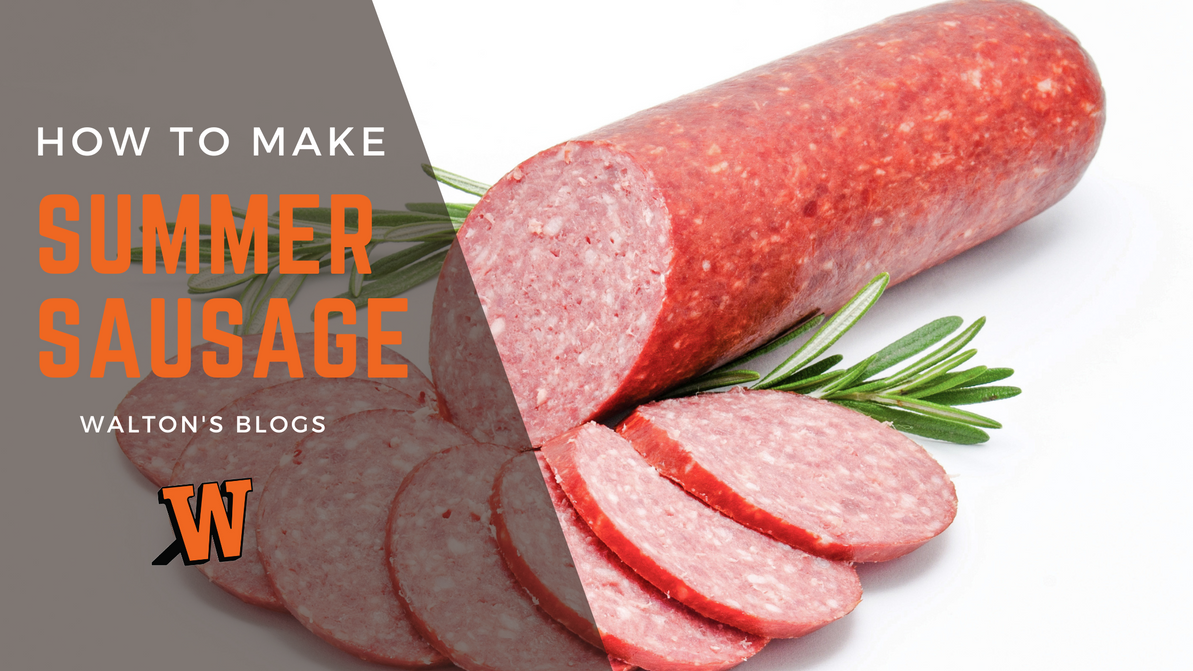How to Make Summer Sausage
Summer Sausage is a semi-dried sausage that is typically stuffed into a larger diameter casing, like fibrous sausage casings. Most summer sausage has a low pH, which gives it that familiar tangy flavor. pH values can range from 4.5 to 5.2, and this also helps aid in shelf stability. Besides pH, water activity can also help determine whether a product is truly shelf-stable or not, which means in summer sausage, we need to bind water in the meat snacks and make it unavailable for microbial growth. Water activity is not something that a home meat processor can measure, but we still set up our process and thermal processing to attempt to achieve a lower water activity. Summer Sausage can be made using a variety of meats and anything like wild game or venison, beef, pork, poultry, or a combination of meats. Walton’s recommends using a lean-to-fat ratio of at least 80/20, and many times a 30% fat ratio, with a maximum of 40% fat. Fat is where most of your flavor comes from, so changing your lean-to-fat ratio will change the overall taste and mouthfeel of your product.
Summer Sausage is a semi-dried sausage that is typically stuffed into a larger diameter casing, like fibrous sausage casings. Most summer sausage has a low pH, which gives it that familiar tangy flavor. pH values can range from 4.5 to 5.2, and this also helps aid in shelf stability. Besides pH, water activity can also help determine whether a product is truly shelf-stable or not, which means in summer sausage, we need to bind water in the meat snacks and make it unavailable for microbial growth. Water activity is not something that a home meat processor can measure, but we still set up our process and thermal processing to attempt to achieve a lower water activity. Summer Sausage can be made using a variety of meats and anything like wild game or venison, beef, pork, poultry, or a combination of meats. Walton’s recommends using a lean-to-fat ratio of at least 80/20, and many times a 30% fat ratio, with a maximum of 40% fat. Fat is where most of your flavor comes from, so changing your lean-to-fat ratio will change the overall taste and mouthfeel of your product.
Summer Sausage is a semi-dried sausage that is typically stuffed into a larger diameter casing, like fibrous sausage casings. Most summer sausage has a low pH, which gives it that familiar tangy flavor. pH values can range from 4.5 to 5.2, and this also helps aid in shelf stability. Besides pH, water activity can also help determine whether a product is truly shelf-stable or not, which means in summer sausage, we need to bind water in the meat snacks and make it unavailable for microbial growth. Water activity is not something that a home meat processor can measure, but we still set up our process and thermal processing to attempt to achieve a lower water activity. Summer Sausage can be made using a variety of meats and anything like wild game or venison, beef, pork, poultry, or a combination of meats. Walton’s recommends using a lean-to-fat ratio of at least 80/20, and many times a 30% fat ratio, with a maximum of 40% fat. Fat is where most of your flavor comes from, so changing your lean-to-fat ratio will change the overall taste and mouthfeel of your product.
Meat Block
For your meat block, you will need a 50/50 mix of 80/20 Beef and Pork Trim (or pork butts if the trim is not available) or 25 lb 80/20 beef trim, or you can use 20 lb wild game and 5 lb pork fat or beef fat, though beef fat will have a different texture and taste.
Ingredients
Required:
- 1 package of Excalibur Summer Sausage Seasoning of your choice.
- 1 oz of Sure Cure (packet is included with seasoning)
- 2.4 x 12 in Mahogany Fibrous Sausage Casings or other Summer Sausage Casings.
Optional but recommended ingredients:
- 6 oz Sure Cure Meat Binder.
- 4 oz Encapsulated Citric Acid.
- 2 to 3 Ib High Temperature Cheese.
- 2 Quarts of Ice Cold Water
Process
If particle definition in your finished product is important to you then you will want to trim the fat off of your meat. Then grind the meat separately, the fat should be ground twice through a 3/16th plate and the lean should be ground twice. First, through a 3/8" plate, and then through a 1/8" plate. The second grind can take a long time, keeping the meat extremely cold during this process will help immensely. Alternatively, you can use the Walton’s One Shot Grinder which will grind all the meat twice in one pass.
Meat Mixing
Walton's 20 lb Meat Mixer is your best option for meat mixing when making summer sausage. We need to not only thoroughly mix the seasoning, spices, and additives into the meat, but we also need to achieve a good protein extraction. Protein extraction is visibly noticeable when the meat starts to get really sticky. What this does is allow the proteins in the meat to bind with water and fat giving your sausage a better consistency and mouth-feel when eating, plus it helps keep it from being crumbly in the final product. Hand mixing is possible, but difficult to achieve the same result as using an actual meat mixer. For the mixing time, we need to mix for a total of around 8 minutes. As soon as you start mixing, you can add all the ingredients except Encapsulated Citric Acid, which can be added in the last 45 to 60 seconds, or just long enough to evenly disperse. Over mixing Encapsulated Citric Acid can lead to breaking the encapsulation which will release the acid too early and denature your proteins. This will cause your meat to become dry and crumbly.
Sausage Stuffing
Avoid creating air pockets when you load your sausage stuffer and begin stuffing until the casings are full with a smooth exterior. Remember to leave a little extra on the ends of the fibrous casings so you can twist them tight and clip them tightly closed with a pair of hog ring pliers.
Thermal Processing
Either hang on smoke sticks or lay on racks in your smokehouse or oven. Just be sure to leave a slight gap between the Summer Sausages. A simple cooking schedule you can follow is here:
130°F for 1 hour with no smoke or humidity and dampers wide open (Drying phase)140° F for 1 hour add smoke and humidity
150° F for 1 hour with smoke and humidity
(Optional drying phase here of 30 minutes at 150°F for a dryer product)
160° F for 1 hour with smoke and humidity
If your smoker does not start this low you can play around with propping the lid open of your smoker to bleed out some of the heat. If you do not do this (or the below option) you should load all of you sausage into the smoker before you turn it on, this way your sausage will come up to temperature as the smoker does.
Alternatively, if your smoker doesn’t start low enough, you could vacuum seal your summer sausage and then start it out at 90 °F until the temp hits about 90 and transfer it to your smoker at its lowest setting. An extended drying period would need to be run here, which we have not yet created.
Cooling
When your sausage has reached the target temperature it is important to get the sausage right into an ice bath, or a shower cycle in a commercial smokehouse. Dropping the temperature rapidly allows the casing to separate from the meat and helps prevent over-cooking and wrinkling.
Blooming & Packaging
We recommend you let the product hang on a rack for 1-2 hours at room temperature to allow for blooming. Then, move to a refridgerator or cooler overnight.
Take your sausage out of the cooler and let it sit at room temperature for 1 hour before vacuum packing.
More on "How to Make Summer Sausage"
It’s easy to get started on making a basic version of summer sausage, but practice does make perfect! Walton’s has Everything but the Meat to make fantastic tasting and looking summer sausage. Plus, we have tons of knowledge and assistance if you need it for perfecting your own process. If you have any questions or need help in your process, check out or latest Youtube video on “How to Make Summer Sausage” or you can check out out Meatgistics post and comment your questions below!
Recent Posts
-
Introduction to Sausage Making
.blog-post-figure{ display:none; } Are you ready to start your journey into the world …12th Apr 2024 -
BHA Clean-Up
Both, Austin and Jon gave back to the hunters' community with their time and hard work in the for …13th Feb 2024 -
Walton's Gift Guide
Christmas is just around the corner, and we're here to let you know what we personally recommend …7th Dec 2023



